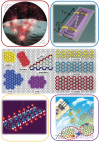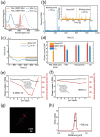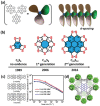Small Size, Big Impact: Recent Progress in Bottom-Up Synthesized Nanographenes for Optoelectronic and Energy Applications
- PMID: 35218329
- PMCID: PMC9259728
- DOI: 10.1002/advs.202106055
Small Size, Big Impact: Recent Progress in Bottom-Up Synthesized Nanographenes for Optoelectronic and Energy Applications
Abstract
Bottom-up synthesized graphene nanostructures, including 0D graphene quantum dots and 1D graphene nanoribbons, have recently emerged as promising candidates for efficient, green optoelectronic, and energy storage applications. The versatility in their molecular structures offers a large and novel library of nanographenes with excellent and adjustable optical, electronic, and catalytic properties. In this minireview, recent progress on the fundamental understanding of the properties of different graphene nanostructures, and their state-of-the-art applications in optoelectronics and energy storage are summarized. The properties of pristine nanographenes, including high emissivity and intriguing blinking effect in graphene quantum dots, superior charge transport properties in graphene nanoribbons, and edge-specific electrochemistry in various graphene nanostructures, are highlighted. Furthermore, it is shown that emerging nanographene-2D material-based van der Waals heterostructures provide an exciting opportunity for efficient green optoelectronics with tunable characteristics. Finally, challenges and opportunities of the field are highlighted by offering guidelines for future combined efforts in the synthesis, assembly, spectroscopic, and electrical studies as well as (nano)fabrication to boost the progress toward advanced device applications.
Keywords: bottom-up synthesis; graphene nanoribbons; nanographenes; optoelectronics; van der Waals heterostructures.
© 2022 The Authors. Advanced Science published by Wiley-VCH GmbH.
Conflict of interest statement
The authors declare no conflict of interest.
Figures







Similar articles
-
Heteroatom-Doped Nanographenes with Structural Precision.Acc Chem Res. 2019 Sep 17;52(9):2491-2505. doi: 10.1021/acs.accounts.9b00322. Epub 2019 Sep 3. Acc Chem Res. 2019. PMID: 31478641 Free PMC article.
-
Photomodulation of Charge Transport in All-Semiconducting 2D-1D van der Waals Heterostructures with Suppressed Persistent Photoconductivity Effect.Adv Mater. 2020 Jul;32(26):e2001268. doi: 10.1002/adma.202001268. Epub 2020 May 6. Adv Mater. 2020. PMID: 32378243
-
van der Waals Heterojunction between a Bottom-Up Grown Doped Graphene Quantum Dot and Graphene for Photoelectrochemical Water Splitting.ACS Nano. 2020 Jan 28;14(1):1185-1195. doi: 10.1021/acsnano.9b09554. Epub 2020 Jan 16. ACS Nano. 2020. PMID: 31934740
-
2D-1D mixed-dimensional heterostructures: progress, device applications and perspectives.J Phys Condens Matter. 2021 Sep 23;33(49). doi: 10.1088/1361-648X/ac2388. J Phys Condens Matter. 2021. PMID: 34479213 Review.
-
Graphene-Based Mixed-Dimensional van der Waals Heterostructures for Advanced Optoelectronics.Adv Mater. 2019 Sep;31(37):e1806411. doi: 10.1002/adma.201806411. Epub 2019 Jul 10. Adv Mater. 2019. PMID: 31503377 Review.
Cited by
-
Theoretical Study on Vibrationally Resolved Electronic Spectra of Chiral Nanographenes.Molecules. 2024 Aug 23;29(17):3999. doi: 10.3390/molecules29173999. Molecules. 2024. PMID: 39274847 Free PMC article.
-
One-Pot Synthesis of Nitrogen-Doped Graphene Quantum Dots and Their Applications in Bioimaging and Detecting Copper Ions in Living Cells.ACS Omega. 2023 Jul 23;8(30):27333-27343. doi: 10.1021/acsomega.3c02705. eCollection 2023 Aug 1. ACS Omega. 2023. PMID: 37546585 Free PMC article.
-
Ring Contraction of Cyclooctatetraenes toward Non-Benzenoid Polycyclic Aromatic Hydrocarbons by Au(111)-Catalysis and Bulk Pyrolysis.Chemistry. 2025 Jul 17;31(40):e202501101. doi: 10.1002/chem.202501101. Epub 2025 Jun 27. Chemistry. 2025. PMID: 40576555 Free PMC article.
-
Device Applications Enabled by Bandgap Engineering Through Quantum Dot Tuning: A Review.Materials (Basel). 2024 Oct 31;17(21):5335. doi: 10.3390/ma17215335. Materials (Basel). 2024. PMID: 39517603 Free PMC article. Review.
-
Synthesis of zigzag- and fjord-edged nanographene with dual amplified spontaneous emission.Chem Sci. 2022 Oct 18;13(44):13040-13045. doi: 10.1039/d2sc04208h. eCollection 2022 Nov 16. Chem Sci. 2022. PMID: 36425485 Free PMC article.
References
-
- Geim A. K., Novoselov K. S., Nat. Mater. 2007, 6, 183. - PubMed
-
- Bonaccorso F., Colombo L., Yu G., Stoller M., Tozzini V., Ferrari A. C., Ruoff R. S., Pellegrini V., Science 2015, 347, 6217. - PubMed
-
- Koppens F. H. L., Mueller T., Avouris P., Ferrari A. C., Vitiello M. S., Polini M., Nat. Nanotechnol. 2014, 9, 780. - PubMed
-
- Bonaccorso F., Sun Z., Hasan T., Ferrari A. C., Nat. Photonics 2010, 4, 611.
-
- Chen Z., Narita A., Müllen K., Adv. Mater. 2020, 32, 2001893. - PubMed
Publication types
Grants and funding
LinkOut - more resources
Full Text Sources
